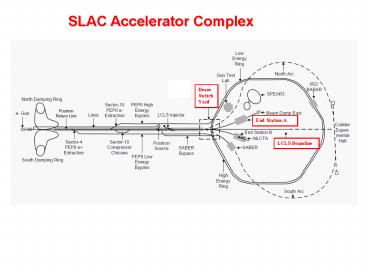SLAC Accelerator Complex - PowerPoint PPT Presentation
1 / 7
Title:
SLAC Accelerator Complex
Description:
PM1, PM2: new or refurbished pulsed magnets, used to deflect ~few Hz beam ... Use PM1 to deflect 1-10Hz primary beam onto Be production target to obtain ... – PowerPoint PPT presentation
Number of Views:28
Avg rating:3.0/5.0
Title: SLAC Accelerator Complex
1
SLAC Accelerator Complex
Beam Switch Yard
End Station A
LCLS Beamline
2
Pulsed Magnet Region in Beam Switch Yard
A-Line 0.5 deg
Tungsten Vertical Collimator
B1
PM1
PM2
B2
LCLS Beamline
Off-axis Be Target
D10 Tune-up Dump
30 feet
B-Line
- B1, B2 existing dc magnets,
- PM1, PM2 new or refurbished pulsed magnets,
used to deflect few Hz beam - 0.5-degrees into A-line, or
- onto Be target for secondary hadron production
to A-line - Tungsten collimator to intercept (0.1-1 pC) LCLS
beam halo - potential for 2-6 GeV single electrons parasitic
to LCLS operation
200 feet
120Hz LCLS beam operation
3
Proposed Test Beams to End Station A
- Primary beam
- Accelerator Science, Beam Instrumentation and
Beam Dump experiments - Secondary beam (primarily electrons, pions)
- Detector RD for HEP, including particle
astrophysics - e.g. silicon and pixel detectors, GEM and
RPCs, - precision time-of-flight and photon
detections systems, calorimetry
- Test Beams
- 14-GeV electrons (also, low intensity electrons
at lower momenta) - Use PM1 and PM2 to obtain 1-10Hz primary beam
into A-line - Variable intensities from single particle to full
beam intensity - (single particle achievable with low
charge, large energy spread bunch hitting thin
target - downstream of D10 before 24-degree A-line
bends use collimators and momentum slit to - control rate)
- 2-6 GeV electrons, parasitic to LCLS
- Collimate LCLS beam halo with tungsten collimator
in BSY - (0.1-1) electron/bunch to ESA possible _at_ 120Hz
PM1 and PM2 not needed - Needs further feasibility studies
- 2-10 GeV hadrons
- Use PM1 to deflect 1-10Hz primary beam onto Be
production target to obtain - 0.2 particles/pulse at 6 GeV (50 positrons,
50 pions)
4
Secondary Electron and Positron Yields in ESA
- EGS4 results for yields per pC halo incident on
target in Beam Switch Yard - 14.1 GeV primary beam energy
- 0.5-deg production angle
- Acceptance 0.14 ?sr , ?E/E 0.02
- LCLS bunch charge is 1 nC (6 109 electrons)
9 mm tungsten target
electrons positrons
5
Secondary Hadron Yields
Measured and predicted (curves) particle fluxes
of secondary beams from SLAC Report 160. (pulse
length is 1.6 ms, so 1mA corresponds to 1010
electrons/pulse)
6
Secondary Hadron Yields
Measured and predicted (curves) particle fluxes
of secondary beams from SLAC Report 160. (pulse
length is 1.6 ms, so 1mA corresponds to 1010
electrons/pulse)
? expect rates up to 0.1 pions/pulse
per 1010 electrons on target ? rates for kaons
and protons x10-50 less
4 6 9
12
Naïve scaling for ESA Proposal ( yields should
be reduced by x300)
7
Pulsed Magnet Region in Beam Switch Yard
Divergent Chamber
A-Line 0.5 deg
D-10
25
Tungsten Vertical Collimator
B1
PM1
PM2
B2
36
LCLS
Off-axis Be Target
B-Line
30 feet
120 feet
80 feet
Notes 1. Tungsten Vertical Collimator has top
and bottom jaws on remote movers that can be
brought to within 1mm of the beam to
intercept the LCLS beam halo and produce
secondary electrons at 0.5-degree production
angle into the A-line. 2. PM1 and PM2 can
operate together to kick the primary beam 0.5
degrees north into the A-Line. 3. PM1 can also
kick the beam 0.25 degrees south onto the
off-axis Be target to produce secondary hadrons
at 0.75-degree production angle to the
A-Line.































